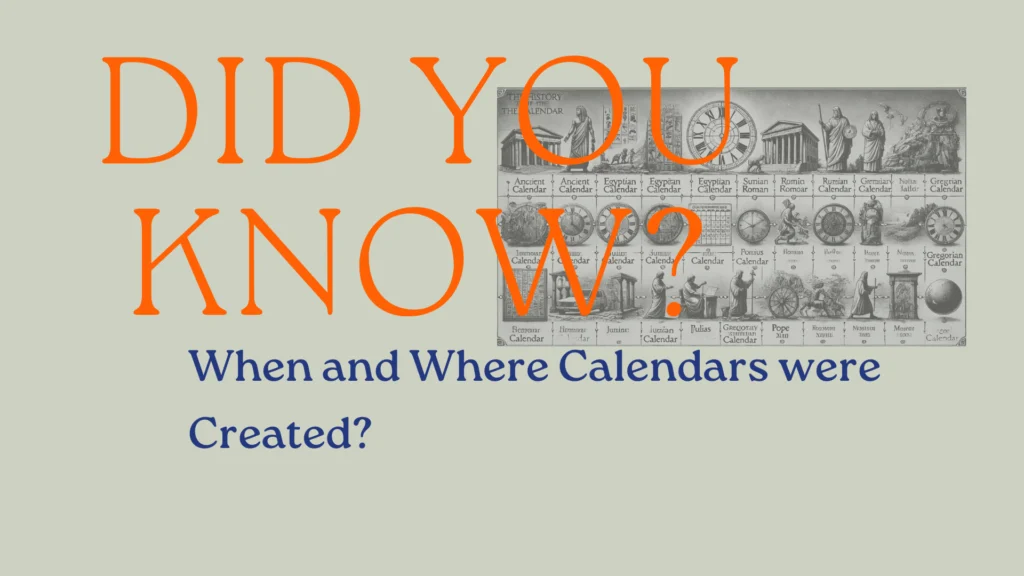History of Calendars | When and Where Calendars Created?

Calendars represent humanity’s fundamental attempt to understand and organize time. More than simple date-tracking tools, they reflect astronomical observations, agricultural needs, and cultural practices.
𝗣𝗿𝗲𝗵𝗶𝘀𝘁𝗼𝗿𝗶𝗰 𝗧𝗶𝗺𝗲𝗸𝗲𝗲𝗽𝗶𝗻𝗴
Long before written language, humans developed sophisticated time-tracking methods:
Astronomical Markers: Prehistoric people used natural phenomena like solstices, equinoxes, and lunar phases to mark time and guide seasonal activities.
Early Evidence*: The 40,000-year-old Geißenklösterle bone from Germany, carved with lunar phase markings, demonstrates complex prehistoric timekeeping.
𝗘𝗮𝗿𝗹𝘆 𝗖𝗮𝗹𝗲𝗻𝗱𝗮𝗿 𝗦𝘆𝘀𝘁𝗲𝗺𝘀:
𝐄𝐠𝐲𝐩𝐭𝐢𝐚𝐧 𝐒𝐨𝐥𝐚𝐫 𝐂𝐚𝐥𝐞𝐧𝐝𝐚𝐫 (c. 3100 BC)
The ancient Egyptians created a remarkably precise calendar:
– 365 days divided into 12 months of 30 days, with 5 additional “epagomenal” days
– Closely tied to the annual Nile River flooding
– Reflected advanced astronomical and mathematical understanding
𝗕𝗮𝗯𝘆𝗹𝗼𝗻𝗶𝗮𝗻 𝗟𝘂𝗻𝗮𝗿-𝗦𝗼𝗹𝗮𝗿 𝗖𝗮𝗹𝗲𝗻𝗱𝗮𝗿 (c. 2000 BC)
The Babylonians developed an intricate calendar system:
– Lunar calendar with alternating 29 and 30-day months
– Implemented intercalation to synchronize lunar and solar years
– Advanced astronomical calculation methods that influenced later systems
𝗠𝗮𝘆𝗮𝗻 𝗟𝗼𝗻𝗴 𝗖𝗼𝘂𝗻𝘁 𝗖𝗮𝗹𝗲𝗻𝗱𝗮𝗿 (c. 2000 BC)
The Mayan civilization created a mathematically complex calendar:
– Multiple interconnected cycles: 260-day ritual Tzolkin and 365-day solar Haab
– Could track time over incredibly long periods
– Integrated sophisticated astronomical observations with cosmological concepts
𝗘𝘃𝗼𝗹𝘂𝘁𝗶𝗼𝗻 𝗧𝗼𝘄𝗮𝗿𝗱𝘀 𝗠𝗼𝗱𝗲𝗿𝗻 𝗖𝗮𝗹𝗲𝗻𝗱𝗮𝗿𝘀
𝗥𝗼𝗺𝗮𝗻 𝗮𝗻𝗱 𝗝𝘂𝗹𝗶𝗮𝗻 𝗥𝗲𝗳𝗼𝗿𝗺𝘀
Julius Caesar’s calendar reform in 45 BC was pivotal:
– Replaced the Roman lunar calendar with a solar-based system
– Introduced a 365.25-day year with a leap year every four years
– Standardized time measurement across the Roman Empire
𝗚𝗿𝗲𝗴𝗼𝗿𝗶𝗮𝗻 𝗖𝗮𝗹𝗲𝗻𝗱𝗮𝗿: 𝗧𝗵𝗲 𝗚𝗹𝗼𝗯𝗮𝗹 𝗦𝘁𝗮𝗻𝗱𝗮𝗿𝗱
Gregorian Calendar which is used widely throughout the world was introduced by Pope Gregory XIII in 1582:
– Corrected inaccuracies in the Julian calendar’s leap year calculation
– Removed 10 days to realign with solar years
– Became the global standard for civil and scientific timekeeping
𝐈𝐬𝐥𝐚𝐦𝐢𝐜 𝐂𝐚𝐥𝐞𝐧𝐝𝐚𝐫 (Hijri Calendar)
The Islamic calendar, also known as the Hijri calendar, was introduced by Caliph Umar ibn al-Khattab (RA) in 638 AD. It marks the year when the Prophet Muhammad (PBUH) and his followers migrated from Makkah to Madinah — known as the Hijrah — as its starting point.
The Islamic calendar is lunar-based, consisting of 12 months in a year of 354 or 355 days. It’s widely used for Islamic events like Ramadan, Hajj, and Eid celebrations.
𝗖𝘂𝗹𝘁𝘂𝗿𝗮𝗹 𝗦𝗶𝗴𝗻𝗶𝗳𝗶𝗰𝗮𝗻𝗰𝗲
Calendars are more than mathematical tools—they are windows into human cultural complexity:
– Reflect agricultural cycles and seasonal changes
– Encode religious and cultural practices
– Demonstrate mathematical and astronomical understanding
– Serve as tools for social coordination and cultural memory
From prehistoric bone carvings to digital systems, calendars represent humanity’s perpetual quest to understand and organize time, revealing our remarkable capacity for observation, calculation, and abstraction.
